In this blog, I will review the export statistics of the world’s leading shrimp suppliers, focusing strongly on Ecuador and India and covering some other major producers. I will look at the long-term trend and the performance in Q1 2024. On top of that, I'm sharing a unique perspective on the stocking status in Andhra Pradesh, India, based on GalaxEye Blue Track, a satellite monitoring product for the shrimp industry.
In 2024, the Shrimp Blog is supported by: Inve Aquaculture, Taprobane Seafoods, DSM-Firmenich, Zeigler Nutrition, Bioiberica, Megasupply, American Penaeid, Omarsa and eFishery.

Key takeaways
Overall
- In 2023, Ecuador, India, Indonesia, and Vietnam combined saw their exports drop by 9% year-on-year. Ecuador’s and India’s exports grew by 14% and 1%. But Indonesia’s and Vietnam’s exports fell by 25% and 10% respectively.
- While Ecuador’s and Indonesia’s exports in Q1 2024 dropped by 8% year-on-year each, exports of Indian and Vietnamese shrimp increased by 4% and 10% (Vietnam’s export volume is only available for Jan-Feb).
- Ecuador, India, Indonesia, and Vietnam saw their combined exports in Q1 decline by 5% year-on-year.
Ecuador
- In 2023, Ecuador’s exports grew by 14% and reached 1.2 million MT. Its export value dropped by 5% to just below $6 billion.
- Ecuador’s exports dropped by 8% to 272,432 MT in Q1 2024, the lowest volume since Q1 2022. The year-on-year drop was the heaviest in March when exports fell by 14%.
- In 2023, exports from Ecuador to China grew by 17%, reaching 714,877 MT. China represented 59% of Ecuador’s total export volume. Exports to Europe grew by 18%, while exports to the US grew by 17%.
- In Q1 2024, exports to China dropped by 27% year-on-year, while exports to the US and Europe increased significantly by 33% and 20% year-on-year, respectively.
India
- India’s shrimp exports 2023 reached 712,914, against most expectations, with 1%, slightly up from 2022. The total export value dropped from $5.5 to $4.9 billion.
- Looking at Q1 2024, we see that India’s shrimp export volume, with 4%, has slightly increased year-on-year again.
- The average export value per kilogram of raw L. vannamei has shown a positive trend in Q1 2024 but is still considerably below 2023.
- India continues to lean heavily on the US and Canada, which combined in Q1 2024 absorbed 46% of raw L. vannamei exports, 23% of raw P. monodon exports, and even 87% of value-added products.
Vietnam
- Vietnam’s export value amounted to $2.8 billion in 2023, down from $4 billion in 2022, a 30% drop. Vietnam’s export volume dropped from 382,341 MT in 2022 to 287,851 MT in 2023, a 25% decline.
- Vietnam’s shrimp exports amounted to $686 million in Q1 2024, an increase of 14% compared to Q1 2023.
- Mirror data from Vietnam’s main trading partners, only available for January and February 2024, suggest a slight increase in export volume from 28,544 MT in 2023 to 31,335 MT in 2024 (10%).
Indonesia
- Total shrimp exports fell by 4% in 2022 and another 9% in 2023. While reporting some growth of exports of other species, the exports of raw frozen L. vannamei dropped by 5% in 2022 and another 22% in 2023. Exports of value-added products (+90% of L. vannamei) dropped less significantly, with only 4% in 2022 and 2% in 2023.
- In Q1 2024, total exports dropped 8% year-on-year. Looking at raw frozen L. vannamei, exports declined even by 18%. Value-added exports fell by 3%. Exports reported as raw frozen P. monodon dropped by 12%. Exports reported as raw frozen other species increased by 20%.
Other exporters
- Venezuela and Peru were the only other major shrimp exporters with significant growth from 2022 to 2023. All other major exporters, such as Thailand, Honduras, China, Bangladesh, and Saudi Arabia, have seen their exports fall or remain flat.

Ecuador
There has been much reporting about Ecuador’s impressive growth. While all significant producers struggled to maintain their export volumes, Ecuador increased its export volume significantly. Although at a slower growth rate than in previous years, this was also the case in 2023, when exports grew by 14% and reached 1.214 million MT. But the growth comes at a cost. Ecuador’s export value in 2023 dropped by 5% to just below $6 billion.
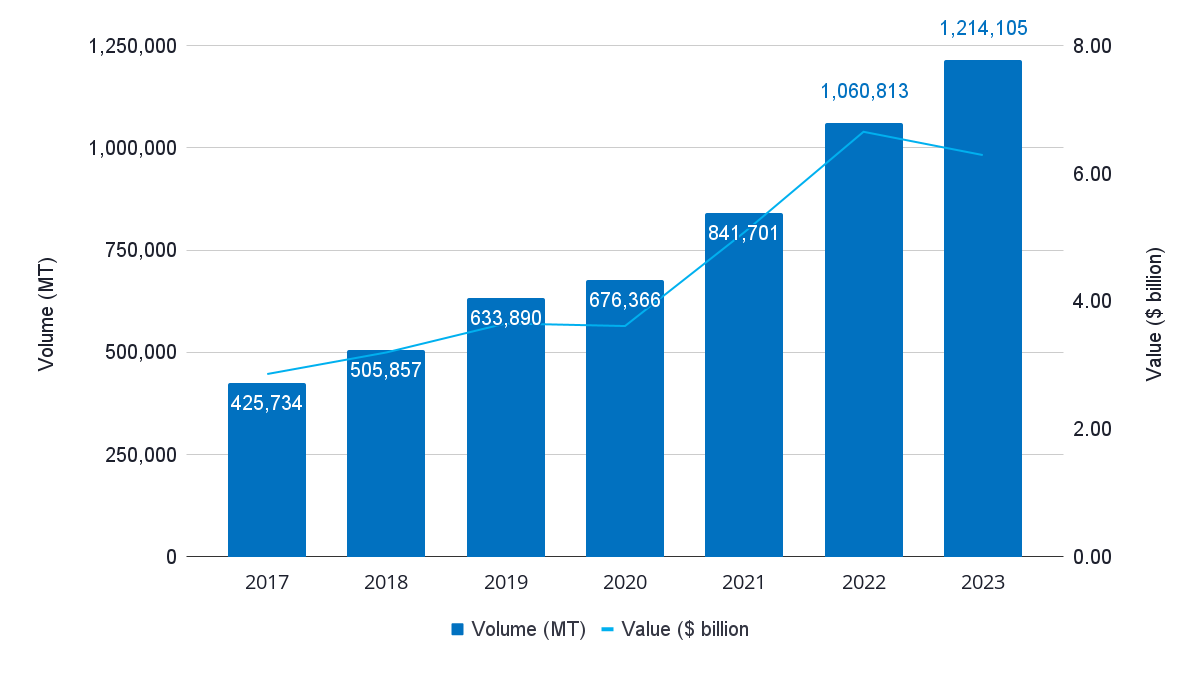
Source: CNA Ecuador
While in 2023, every quarter still outperformed the same quarter of 2022, in Q1 2024, this trend stopped (Figure 2). In Q1 2024, Ecuador’s exports drop by 8% to 272,432 MT, the lowest volume since Q1 2022. The year-on-year drop was the heaviest in March, when exports dropped by 14%. Exports fell 6% and 2% year-on-year in January and February, respectively. The total export value in Q1 2024 declined by 17% to $1.35 billion, the lowest value since Q3 2021.
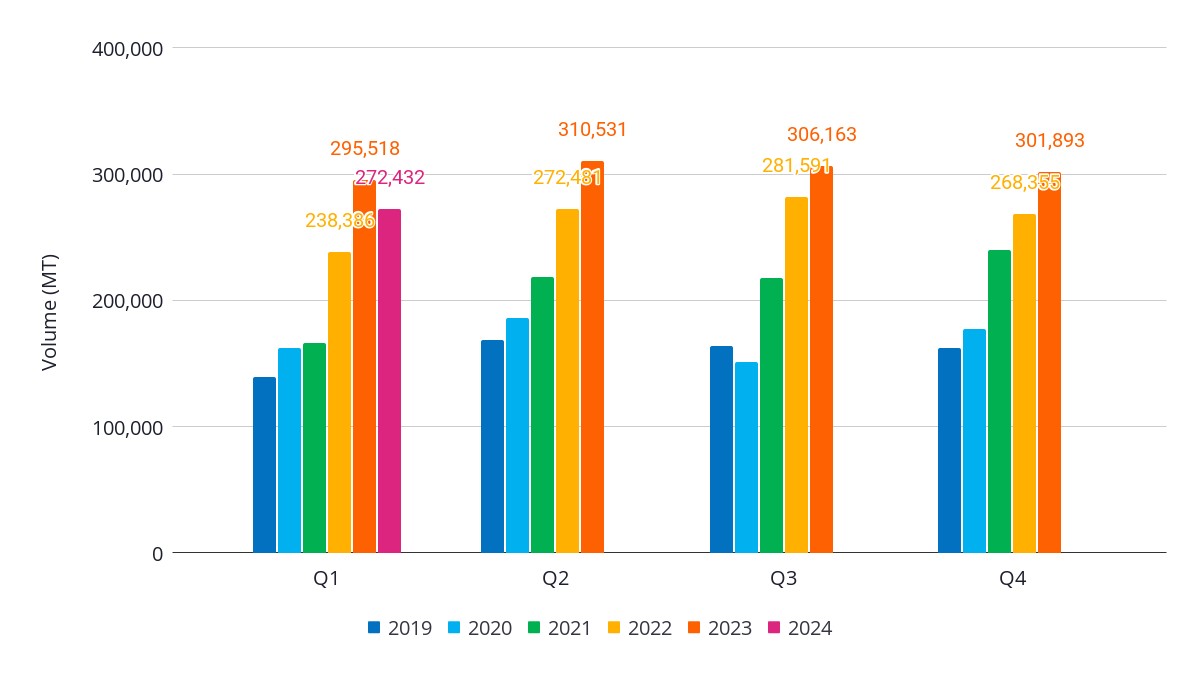
Source: CNA Ecuador
China remains Ecuador’s most important market. It’s where Ecuador sells most of its HOSO-quality products. In 2023, exports from Ecuador to China grew by 17%, reaching 714,877 MT. China represented 59% of Ecuador’s total export volume. Exports to Europe grew by 18%, while exports to the US grew by 17%.
When China's demand softens, exports to other regions, such as the US and EU, increase. An increase in exports to these markets means more HLSO and peeled products. This is important as the Live Weight Equivalent of HLSO and peeled shrimp is larger than its export weight. Thus, if exports to China fall and exports to the US and Europe grow, a decrease in exports does not necessarily mean a reduction in Ecuador’s shrimp production.
This is precisely what happened in Q1 2024 (Figure 3). Exports to China dropped by 27%, while exports to the US and Europe increased by 33% and 20% respectively. In Q1 2024, compared to Q1 2023, China’s share of Ecuador’s exports dropped from 63% to 49%, while the US’s market share increased from 16% to 22% and Europe’s from 14% to 18%. While Ecuador’s total exports in Q1 2024 dropped by 8%, the liveweight equivalent of the export volume may have been flat or even slightly higher due to the higher share of HLSO and peeled products.
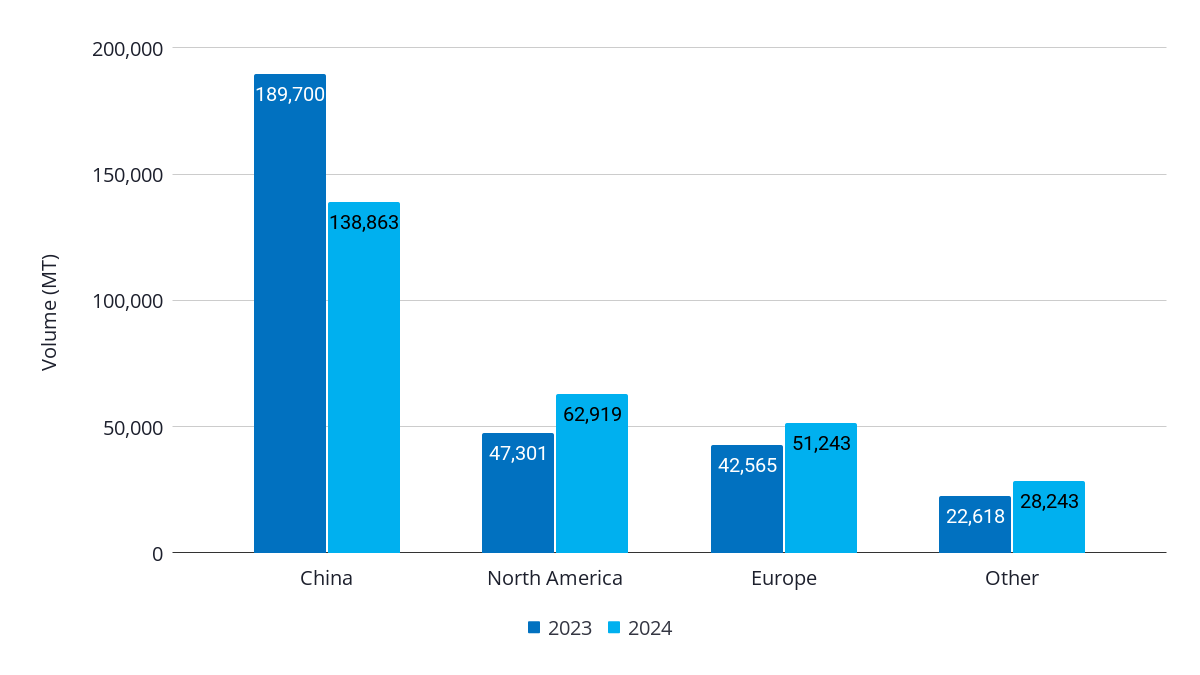
Source: CNA Ecuador
Suppose Ecuador’s Q1 trend continues and its exports ship more products to the US and Europe. In that case, other suppliers will face fierce competition in the HLSO and peeled segments, and pricing may remain under pressure.

GalaxEye Blue Reveals 70% of Shrimp Ponds in Andhra Pradesh Active at the End of April.
Since the beginning of this year, I have worked as an advisor for the Indian Space Tech start-up GalaxEye Space to support the development of its GalaxEye Blue offering for the shrimp industry. Why? Because I believe in the power satellite monitoring can bring to the shrimp industry. Let me show you what GalaxEye today can already do for you.
GalaxEye Blue
GalaxEye Blue is designed to (1) show pond activity at different levels of geoFigureic aggregation, from individual ponds to state level, and (2) to allow users to examine a wide range of water quality parameters at the pond level. Its track product, focusing on monitoring pond stocking status in the six central shrimp farming districts in Andhra Pradesh, is now being commercially launched, and its capabilities are exciting.
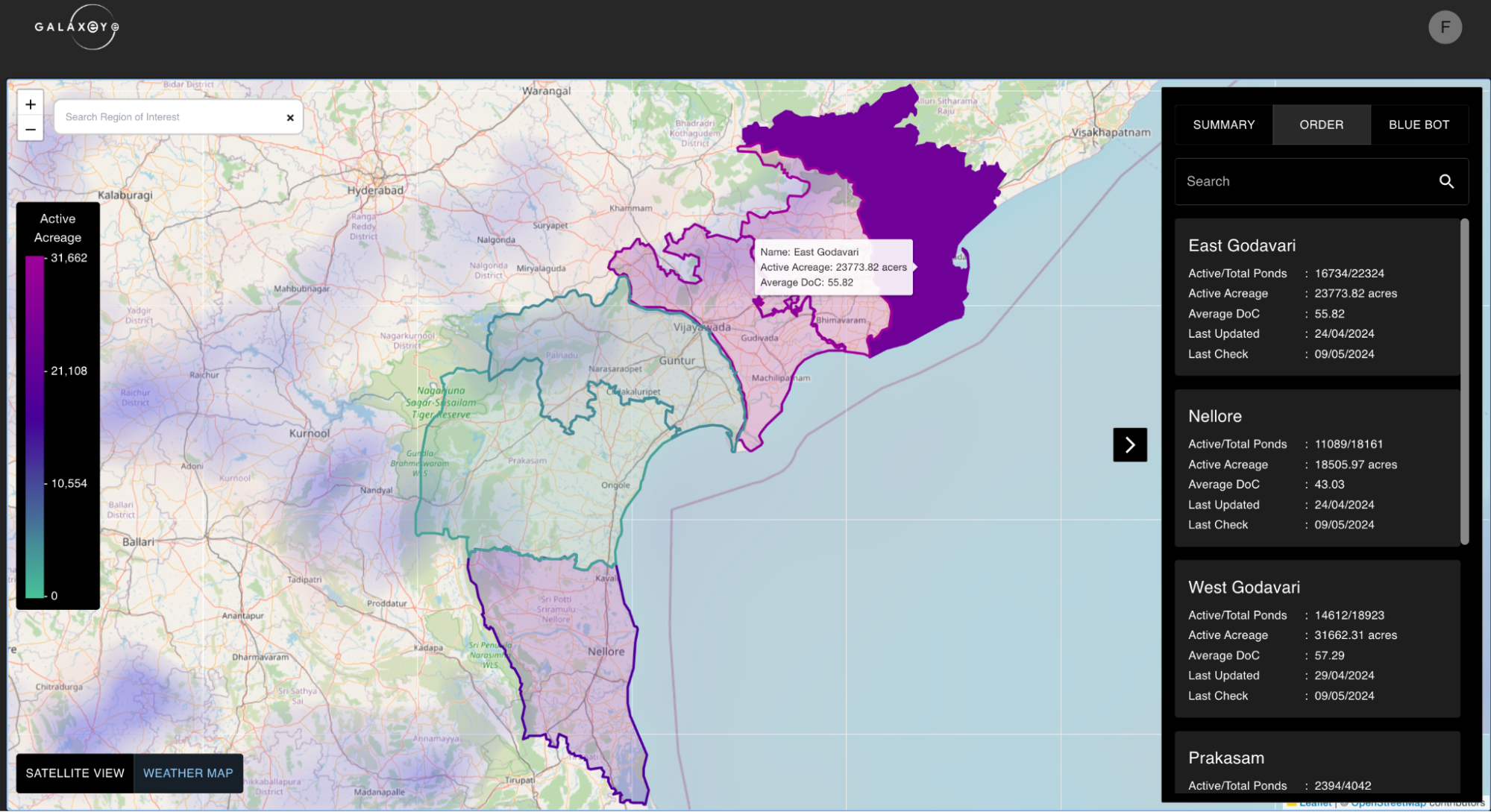
Source: GalaxEye Space
GalaxEye Blue Track has identified each shrimp pond in Andhra Pradesh’s six largest shrimp farming districts (according to the old district division). It knows when each pond was stocked and the current number of days of culture. The system then estimates the shrimp count in each pond. The system aggregates this at the village, sub-district, district, and state levels. The data is updated weekly, and users can access it through an easy-to-handle online dashboard or Excel spreadsheets.
Using the data, companies can better oversee the overall stocking situation and which sizes and volumes are expected where in Andhra Pradesh. This information can be used as an indicator for supply and price forecasting. This should be considered a significant step forward. Previously, the companies depended on intelligence from field teams and a network of middlemen, which comes with all its limitations.

So, what does GalaxEye Blue Track’s data tell us about the situation in Central and Southern Andhra Pradesh?
Historical Development of Total Number of Ponds
Let’s first look at the long-term development. Despite a dip in 2022 and 2023, from 2020 to 2024, GalaxEye Blue observes an increase of 14% in the total number of ponds under shrimp cultivation. The increase has concentrated mostly in Central Andhra Pradesh (Eastern and Western Godavari and Krishna), where it was 17%, and less in Southern Andhra Pradesh (Guntur, Prakasam and Nellore), where it only increased by 8%.
| Year | 2020 | 2021 | 2022 | 2023 | 2024 |
|---|---|---|---|---|---|
| Central Andhra Pradesh | 53,890 | 56,485 | 53,434 | 58,520 | 63,184 |
| Northern Andhra Pradesh | 26,545 | 27,213 | 26,650 | 26,892 | 28,616 |
| Total | 80,435 | 83,698 | 80,084 | 85,412 | 91,800 |
Active vs Total Number of Ponds 29th of April 2024
GalaxEye Blue Track’s dashboard indicates that by 29 April 2024, 71% of the total number of ponds had been actively stocked. The stocking rates were the highest in Central Andhra Pradesh, where they were around 75% already. In Southern Andhra Pradesh, the stocking rates are slightly lower. At request, the stocking rates can be compared with the same dates of previous years so they can be better put into perspective.
| Region | District | Total ponds | Active ponds | % Active |
|---|---|---|---|---|
| Central Andhra Pradesh | East Godavari | 22,324 | 16,734 | 75% |
| West Godavari | 18,923 | 14,612 | 77% | |
| Krishna | 21,937 | 16,257 | 74% | |
| Southern Andhra Pradesh | Guntur | 6,413 | 4,412 | 69% |
| Prakasam | 4,042 | 2,394 | 59% | |
| Nellore | 18,161 | 11,089 | 61% | |
| Total | 91,800 | 65,498 | 71% | |
Estimated Shrimp Counts
Unfortunately, at this point, GalaxEye Blue has not yet estimated biomass. While it’s relatively easy to observe when ponds went into production, the stocking densities and survival rates are unknown. The team is working on providing a calculator that allows a user to enter assumptions on both parameters and then estimate biomass. However, this won’t be part of the standard GalaxEye Blue Track reporting format, as the estimation might be too inaccurate. Therefore, rather than reporting on biomass, GalaxEye Blue Track reports on the number of days of culture and related estimations of the size counts in the ponds. This is presented in Figure 5.
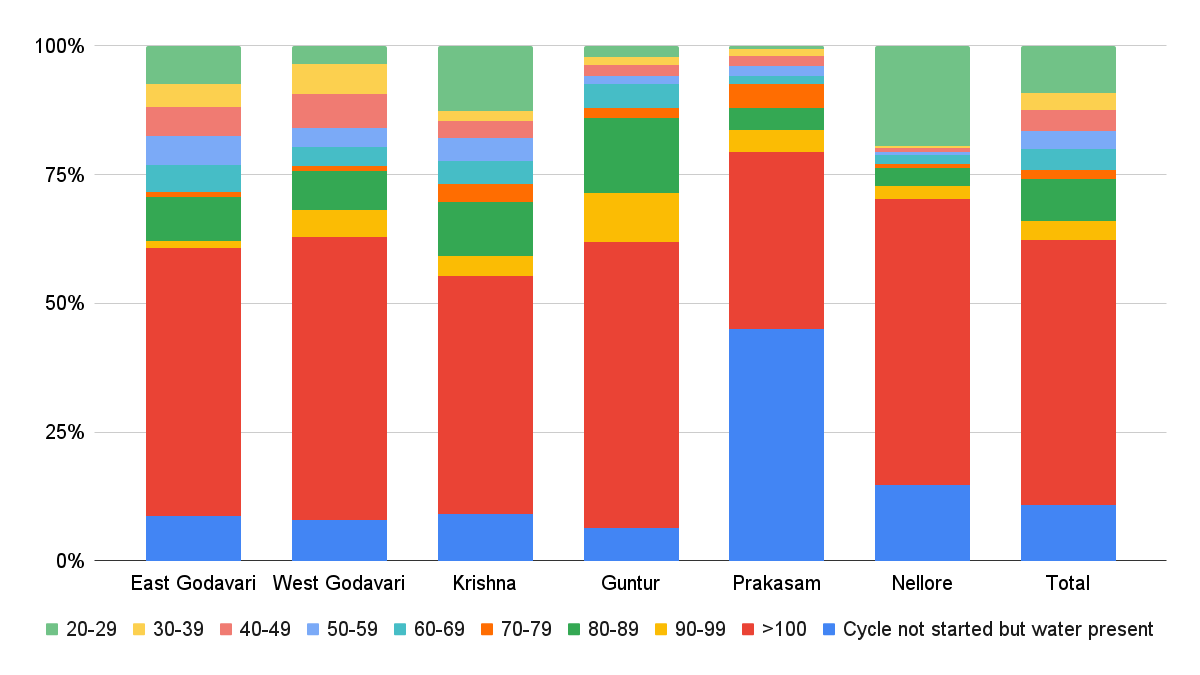
Source: GalaxEye Space
The estimated size distribution of all the stocked ponds suggests that of all active ponds at the end of April, more than 62% were carrying sizes smaller than >100 per kg. Mid and larger sizes were scarcely available, explaining the high level of competition for these raw materials among processors that must fulfill their order books. Mid and larger sizes should only become more readily available towards the beginning of June.
In the reporting format, GalaxEye Blue Track provides a monthly forecast of the future availability of raw material sizes. These forecasts are based on historical averages. The numbers can be broken down to the village level.
Are you curious to learn more?
The GalaxEye team and I are eager to demonstrate the dashboard and discuss how GalaxEye Blue Track can enhance your business. Feel free to reach out at willem@shrimpinsights.com.

India
India’s shrimp exports in 2023 reached 712,914, against most expectations, with 1%, slightly up from 2022. The volume of raw frozen shrimp increased by 3% while the volume of value-added (cooked and breaded) dropped by 13%. Within raw frozen shrimp, L. vannamei accounted for 78% (up 3% from 2022), P. monodon accounted for 5% (up 56% from 2022), and wild-caught shrimp accounted for 8% (down 13% from 2022). The increase in volume came at the cost of a decrease in value; the total export value dropped from $5.5 to $4.9 billion.
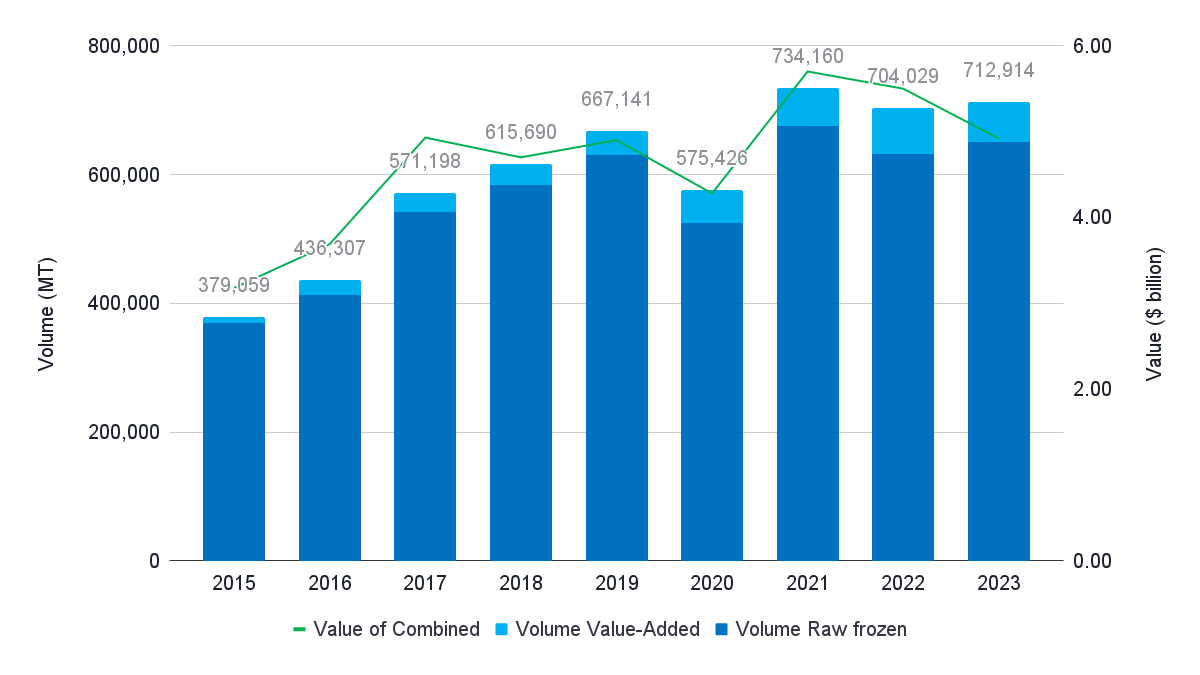
Source: ITC Trademap
Looking at Q1 2024, we see that India’s shrimp export volume, with 4%, has slightly increased year-on-year. Although traditionally the least productive quarter of the year, the slight increase in volume is once again a sign that the farming situation in India is not as bad as some expect.
The rise in volume mainly happened in January and February, when the export volume increased by 9% and 19% year-on-year, respectively. In March 2024, the export volume dropped by 11% year-on-year.
The export increase in Q1 2024 was accounted for by raw L. vannamei (5% year-on-year), raw P. monodon (7% year-on-year), and value-added products also increased (13% year-on-year). Exports of raw P. monodon were flat, and exports of wild-caught shrimp continued to fall (13%).


Source: Ministry of Commerce, India
The average export value per kilogram of raw L. vannamei has shown a positive trend in Q1 2024 (Figure 8). After an almost continuous drop in 2023, prices slightly increased during the year's first quarter. That said, values are still significantly down compared to Q1 2024. The Q1 total export value for raw L. vannamei dropped 5% year-on-year.

Source: Ministry of Commerce, India
In terms of export markets, India continues to lean heavily on the US and Canada, which combined in Q1 2024 absorbed 46% of raw L. vannamei exports, 23% of raw P. monodon exports, and even 87% of value-added products. The US is insignificant only for wild-caught shrimp. With Ecuador’s exports to the US continuing to grow and recent negative attention for the Indian shrimp industry, India’s US-focused exporters will have to work hard to maintain their market share.
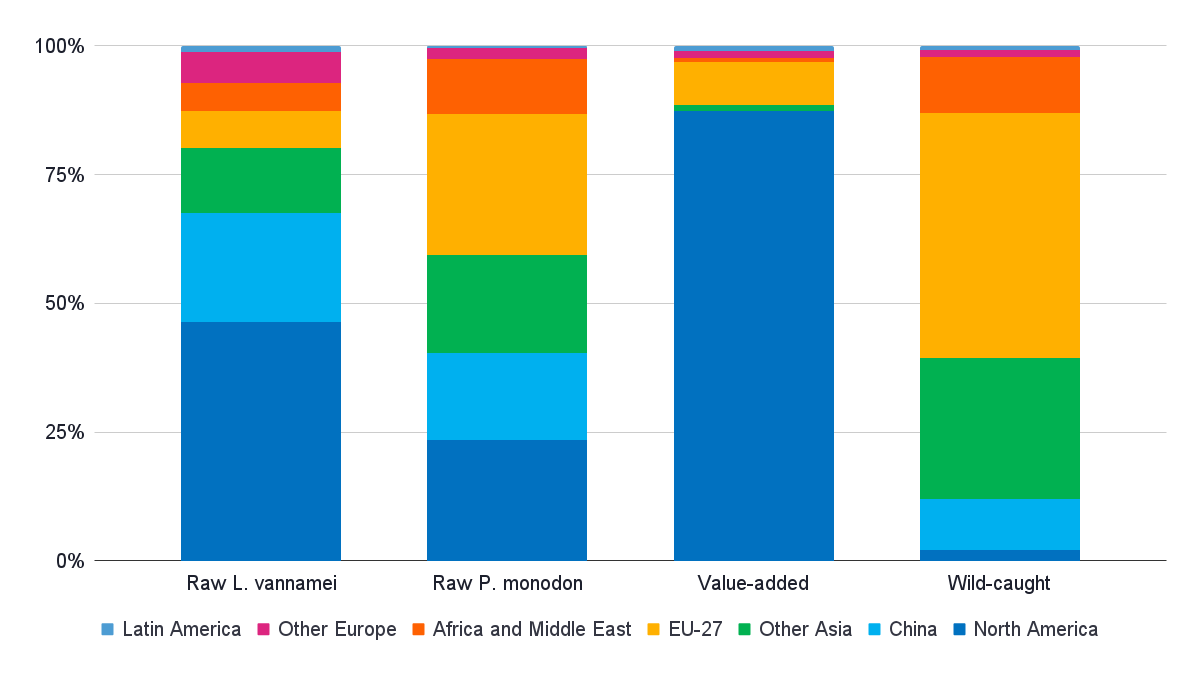
Source: Ministry of Commerce, India
For P. monodon, it’s noteworthy that although in 2023, China and other Asian markets absorbed 50% of its Q1 exports, in Q1 2024, this is down to just 36%. The US and the EU have been more important, importing 23% and 27% of India’s P. monodon exports in Q1 2024.
With India’s farmers primarily targeting large sizes, Asian markets have the largest potential to absorb India’s exports at favorable prices. Therefore, hopefully, these markets will pick up imports from India soon. It has to be emphasized that as the P. monodon crop started only in February and lasts for 8-9 months, a peak in harvests and exports should not be expected before the end of September or even October this year.

Vietnam
Vietnam's Association of Seafood Exporters and Processors (VASEP) regularly publishes trade data. Unfortunately, the organization can only report values, as Vietnam’s government does not report export volumes. Therefore, I will play around with direct and mirror data to provide you with a good understanding of the situation.
Let’s first look at 2023, when Vietnam’s export value dropped to its lowest since 2017 (Figure 10). The export value amounted to $2.8 billion, down from $4 billion in 2022, a drop of 30%. Using the same mirror data, Vietnam’s export volume dropped from 382,341 MT in 2022 to 287,851 MT in 2023, a decline of 25% and the lowest export volume since 2016. With these numbers, we can conclude Vietnam has been the worst hit of all major shrimp producers amidst the global oversupply situation.
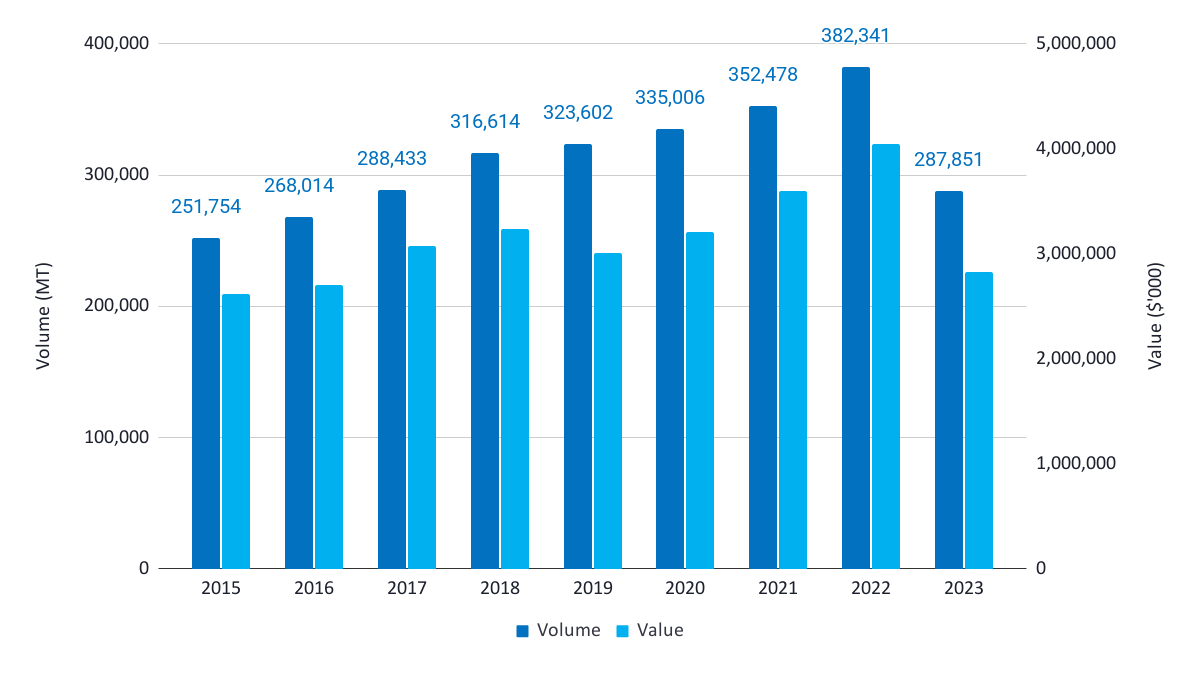
Source: ITC Trademap
Let’s now look at 2024. According to VASEP’s quarterly report, Vietnam’s shrimp exports increased from $600 million in Q1 2023 to $686 million in Q1 2024, an increase of 14%. VASEP reports that L. vannamei exports in Q1 reached $500 million, of which $279 million was accounted for by raw frozen products and 223 million by value-added products. The value of raw frozen products increased by 19% year-on-year, and the value of value-added products by 3%. L. vannamei shrimp products make up 73% of Vietnam’s total shrimp exports in Q1 2024. P. monodon accounted for 12% of total shrimp exports. The export value of the species fell by 4%. Raw frozen P. monodon accounted for $68 million and was 9% down. Value-added P. monodon accounted for $12 million and was 35% up. Wild-caught shrimp accounts for the remaining 15% of exports, and the export value in Q1 2024 was up 59% year-on-year.

Multiple sources
Although we don’t have official export volumes reported by Vietnam’s government, we have two sources of information confirming that the value has increased and the volume has most likely. First, statistics from the Department of Fisheries report a slight increase of 6% in L. vannamei production and an increase of 2% in P. monodon production. Second, also mirror data from Vietnam’s main trading partners (US, EU, China, Japan, South Korea, and the UK), only available for January and February 2024, suggest a slight increase in export volume from 28,544 MT in 2023 to 31,335 MT in 2024 (10%), pretty much in line with the rise in value for Q1 2024 as reported by VASEP. These numbers confirm that the situation in Vietnam has slightly improved compared to Q1 2024.

Indonesia
Due to the absence of the BKIPM import-export portal, which has been down for several months, I have decided to shift my source for Indonesian trade data to BPS, which is the source that other shrimp trade reporters mostly also use. It’s less up-to-date, but it includes all species. I limit my reporting to HS 030617 and HS 1605, which include all farmed shrimp but may exclude some small quantities of wild-caught shrimp.
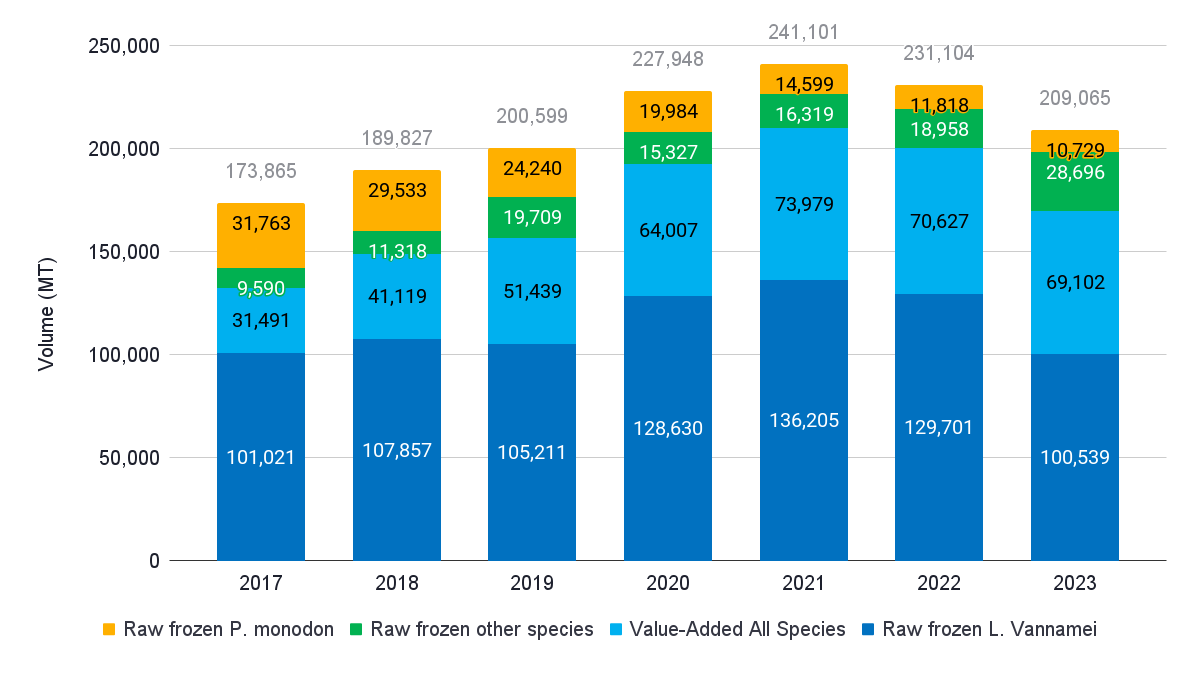
Source: BPS, Indonesia
Figure 13 illustrates years of export volume growth (mainly by raw frozen L. vannamei and value-added products). From 2021, the tide turned, and total exports dropped in 2022 and 2023. Total exports fell by 4% in 2022 and another 9% in 2023. Having reported some growth of exports of other species, the exports of raw frozen L. vannamei dropped by 5% in 2022 and another 22% in 2023. Exports of value-added products (+90% of L. vannamei) dropped less significantly, with only 4% and 2%.
It’s good to mention that while exports of P. monodon reported under its own HS code have fallen, exports of other shrimp species (reported under another HS code) have grown over the same period. It could result from a change in the HS codes under which Indonesian authorities report numbers for P. monodon and other species. However, if these numbers are correct, it means that while exports of farmed P. monodon dropped, exports of wild-caught Penaeus species increased.

Source: BPS, Indonesia
Indonesia remains heavily dependent on the US for its export markets for raw L. vannamei and value-added products (Figure 14). However, fierce competition from Ecuador is challenging its position. While not a significant supplier of peeled products, Indonesia remains an important supplier of raw HLSO (including EZP) and value-added products (including cooked and breaded).
Fierce competition from India has to be expected, especially regarding cooked and breaded products, as India looks to diversify into these value-added products. So far, Indonesia seems unable to diversify its markets for raw L. vannamei and value-added products. Although China sometimes buys significant quantities, this demand appears to be highly volatile. Also, other Asian markets and the EU seem not to have significantly increased their imports from Indonesia.
This is different for other species (P. monodon and wild-caught Penaeus). Indonesia exported P. monodon and wild-caught Penaeus primarily to Asia (around 50%) and within Asia, primarily to Japan. But in 2022 and 2023, China has increased its imports from Indonesia significantly. It even became Indonesia’s most important trading partner. Amidst increased competition in the US, Chinese demand for Indonesian shrimp is a good sign.
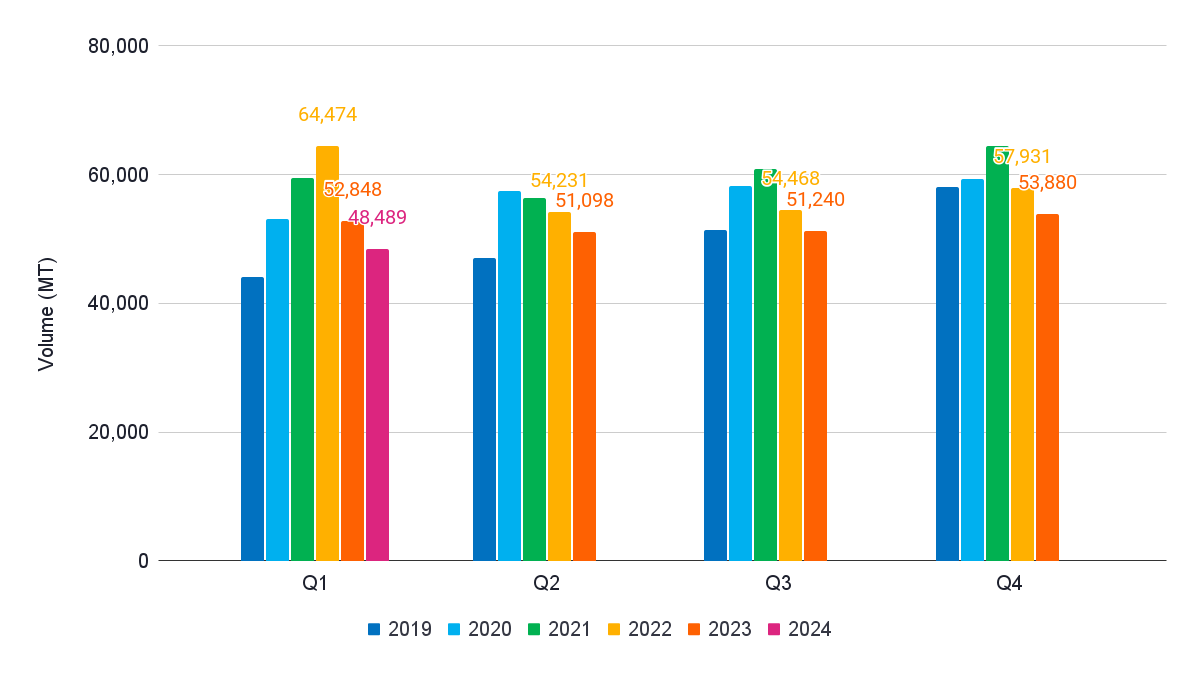
Source: BPS, Indonesia
In Figure 14, Q1 2024 export data illustrates that the negative trend of Indonesia’s shrimp exports has yet to turn. In Q1 2024, total exports dropped 8% year-on-year. Looking at raw frozen L. vannamei, exports declined even by 18%. Value-added exports fell by 3%. Exports reported as raw frozen P. monodon dropped by 12%. Exports reported as raw frozen other species increased by 20%.
